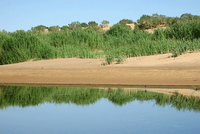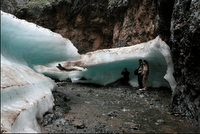Gobi Gurvansaikhan park encompasses the series of ridges and valleys that make up the eastern end of the Gobi Altai mountains. Surrounded by low plains, the mountains rise to 2200-2600 meters, and include the Gurvan saikhan (three adjacent ridges named Zuun (East), Dund (Middle), and Baruun (West) saikhan), Zoolon, Sevrei, Gilbent, and Nemegt ridges. Some of the peaks are volcanic in origin.
 The park, which extends for more than 380 kilometers from east to west, lies at the northern edge of the Gobi desert but includes desert steppe and steppe at higher elevations. The park's landscape is extremely varied, with rocky and sandy desert plains, precipitous cliffs and ravines, salt pans, and oases. Gurvansaikhan includes the highest diversity of plant life in the Gobi Altai, with over 620 species of flowering plants. Most are characteristic of Central Asian deserts, including 38 endemic species. During years with adequate precipitation, desert plants produce vibrant summer displays of desert flowers.
The park, which extends for more than 380 kilometers from east to west, lies at the northern edge of the Gobi desert but includes desert steppe and steppe at higher elevations. The park's landscape is extremely varied, with rocky and sandy desert plains, precipitous cliffs and ravines, salt pans, and oases. Gurvansaikhan includes the highest diversity of plant life in the Gobi Altai, with over 620 species of flowering plants. Most are characteristic of Central Asian deserts, including 38 endemic species. During years with adequate precipitation, desert plants produce vibrant summer displays of desert flowers.
 Fifty-two species of mammals are found here, including eight species listed in the Mongolian Red Book as endangered. Small herds of wild ass and black-tailed and Mongolian gazelle roam the desert valleys and desert steppe, while the mountains provide suitable habitat for threatened and endangered animals such as argali, Siberian ibex, and snow leopard. Long-eared hedgehogs and dwarf hamsters inhabit sandy areas. Over 240 bird species occur in the area, including 34 resident species, 99 breeding species, and 70 migrants.
Local herders seasonally graze livestock in parts of the park, which features some popular tourist destinations, including the Valley of Yol, a picturesque gorge, and the Singing Sands, a spectacular sea of sand dunes bordered by red sandstone formations, an oasis, and a saxaul forest. The Nemegt, Khermiin Tsav, Naran daats, and Bayanzag mountains, the sites of numerous important dinosaur fossil discoveries, also lie within the park.
Fifty-two species of mammals are found here, including eight species listed in the Mongolian Red Book as endangered. Small herds of wild ass and black-tailed and Mongolian gazelle roam the desert valleys and desert steppe, while the mountains provide suitable habitat for threatened and endangered animals such as argali, Siberian ibex, and snow leopard. Long-eared hedgehogs and dwarf hamsters inhabit sandy areas. Over 240 bird species occur in the area, including 34 resident species, 99 breeding species, and 70 migrants.
Local herders seasonally graze livestock in parts of the park, which features some popular tourist destinations, including the Valley of Yol, a picturesque gorge, and the Singing Sands, a spectacular sea of sand dunes bordered by red sandstone formations, an oasis, and a saxaul forest. The Nemegt, Khermiin Tsav, Naran daats, and Bayanzag mountains, the sites of numerous important dinosaur fossil discoveries, also lie within the park.




4 comments:
That's nice! Some more photos!
I believe it's very nice place for photographing wildlife. i have a plan to visit next year to Mongolia. When is the right time/period & where is the right place?
Hi, John,
Yes. Mongolia is very nice place for photographing wildlife. from May to September is best time for travelling in Mongolia. Best place will be depend on your subject. Next summer we will organize two tour. One will be historic, other one will be birding tour. You can join us.
Hi Gansukh,
Thanks for info. I will join with you on bird watching/photographing tour. I will send you my private e-mail address & please send me exact date/tour info. I will prepare my things.
regards,
John.
Post a Comment